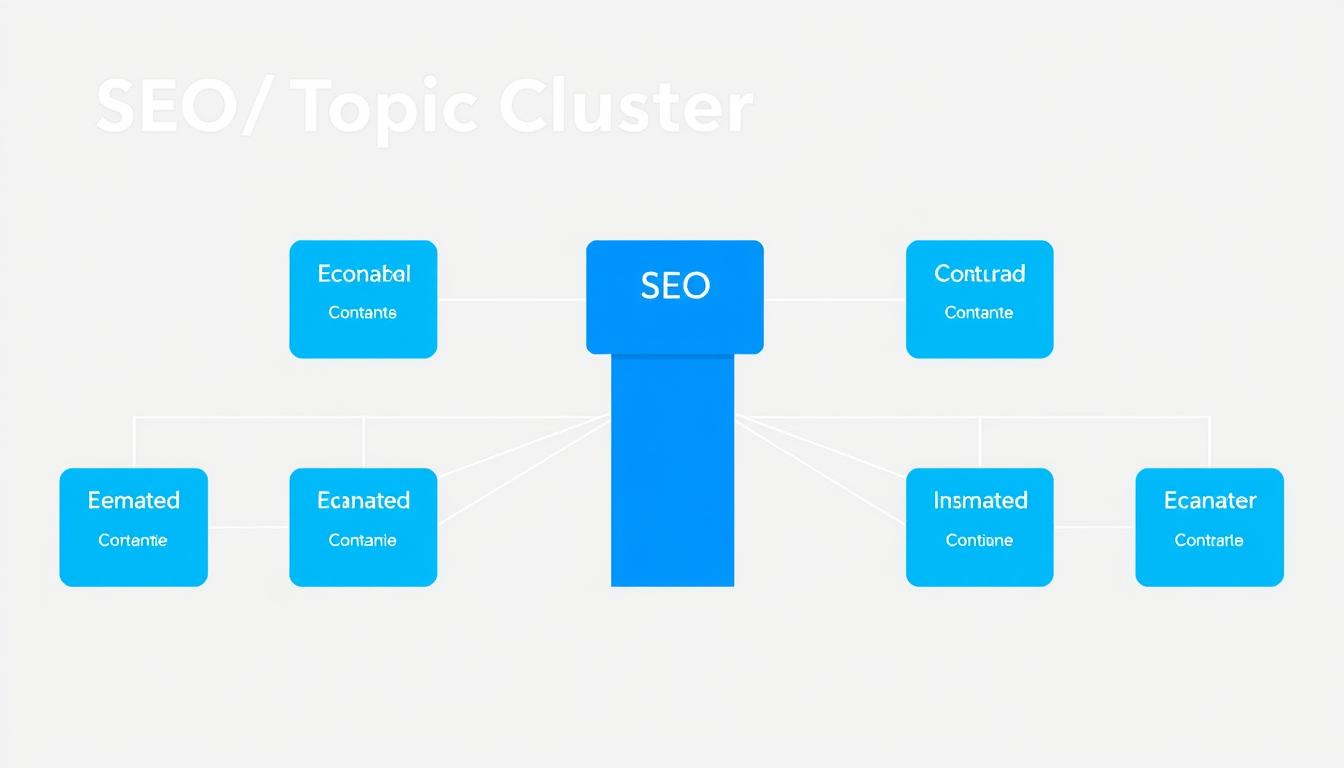SEO Topic Clusters: Complete Guide with Templates & Examples
In today’s evolving search landscape, organizing your content strategically has become crucial for SEO success. Search engines have shifted from focusing on individual keywords to understanding topics as a whole. This is where SEO topic clusters come in – a content organization method that can significantly boost your website’s authority and visibility.
This comprehensive guide will walk you through everything you need to know about topic clusters: what they are, why they matter, and how to implement them effectively. Plus, you’ll get access to free templates to streamline your implementation process.
Get Your Free Topic Cluster Templates
Download our complete set of SEO topic cluster templates to save hours of planning and implementation time.
What Are SEO Topic Clusters?
Topic clusters are a strategic content organization model that helps search engines understand the relationship between your content pieces and establishes your website as an authority on specific subjects.
The basic structure of an SEO topic cluster
A topic cluster consists of three essential components:
- Pillar content: A comprehensive page that broadly covers a main topic and links to more specific cluster content.
- Cluster content: Multiple content pieces that explore specific aspects of the main topic in greater depth.
- Internal linking structure: Strategic links that connect the pillar content to each cluster piece and sometimes link between related cluster content.
This organization creates a clear content hierarchy that both users and search engines can easily navigate and understand.
Why Topic Clusters Matter for Modern SEO
Search engines like Google have evolved significantly in recent years. With updates like Hummingbird (2013) and RankBrain (2015), Google shifted from a keyword-focused approach to understanding topics and search intent.
Traditional Keyword Approach
- Focuses on individual keywords
- Often leads to content cannibalization
- Creates disorganized site architecture
- Makes it harder for search engines to understand content relationships
- Results in competing pages for similar terms
Topic Cluster Approach
- Organizes content around topics
- Creates clear content hierarchies
- Establishes topical authority
- Improves internal linking structure
- Helps search engines understand content relationships
As Jonny Nastor, Founder at Digital Commerce Partners, notes: “Google’s AI-driven algorithms now focus less on keywords and more on intent, interpreting search queries in context and linking them to broader topics. This shift forces SEOs to structure content around search intent, ensuring it aligns with how Google connects related queries.”
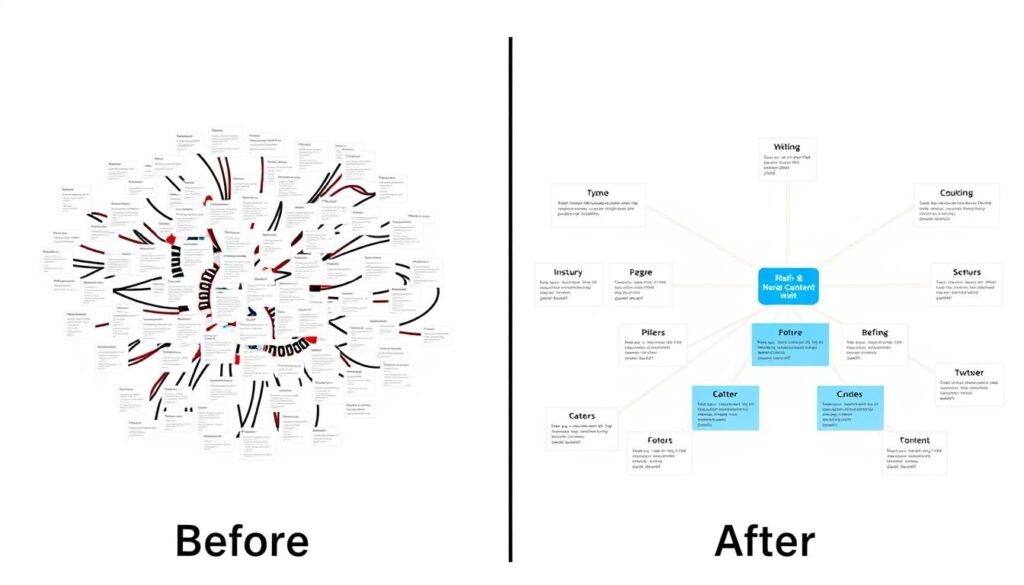
Website structure before and after implementing topic clusters
Core Components of Effective Topic Clusters
1. Pillar Pages
Pillar pages serve as the foundation of your topic clusters. These comprehensive resources cover a broad topic in a way that’s both thorough and accessible.
“When considering whether something should be a pillar page, ask yourself: Would this page answer every question the reader who searched X keyword had, AND is it broad enough to be an umbrella for 20-30 posts?”
Effective pillar pages:
- Cover a broad topic comprehensively
- Are typically longer (2,000+ words)
- Link to all related cluster content
- Target broader, higher-volume keywords
- Provide a complete overview of the topic
2. Cluster Content
Cluster content consists of more focused articles that explore specific aspects of your main topic in greater detail. Each piece of cluster content should:
- Focus on a specific subtopic or long-tail keyword
- Link back to the pillar page
- Provide in-depth information on a narrow aspect
- Answer specific questions related to the main topic
- Target more specific search intent
3. Internal Linking Structure
The strategic linking between your pillar and cluster content is what makes this model so effective. Your internal linking strategy should:
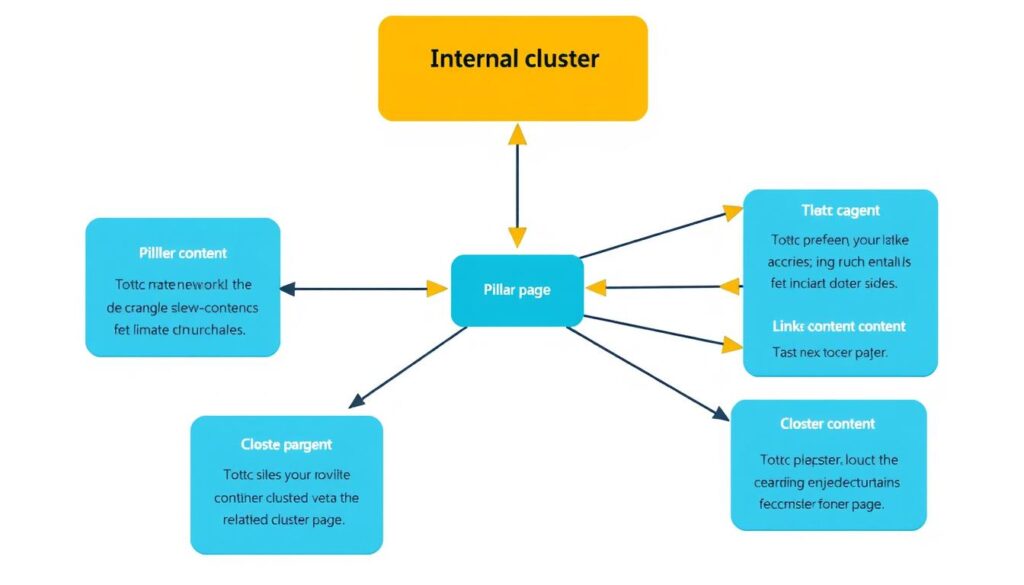
Internal linking structure in a topic cluster model
- Link from the pillar page to each piece of cluster content
- Link from each cluster content back to the pillar page
- Use consistent anchor text that reflects the topic relationship
- Consider strategic cross-linking between related cluster content
- Avoid excessive or irrelevant internal linking
Step-by-Step Implementation Guide
Need a Shortcut?
Skip the manual planning process with our ready-to-use topic cluster templates.
Step 1: Choosing Pillar Topics
Selecting the right pillar topics is crucial for building effective topic clusters. Your pillar topics should be:
- Relevant to your business and audience
- Broad enough to support multiple cluster content pieces
- Specific enough to establish topical authority
- Aligned with your business goals and expertise
- High search volume potential with informational intent
Pro Tip: Map out 5-10 core problems your buyer persona has, then group these problems into broad topic areas. These groupings often make excellent pillar topics.
Step 2: Conducting Keyword Research for Cluster Content
Once you’ve identified your pillar topics, it’s time to research related subtopics and keywords for your cluster content:

Keyword research process for identifying cluster content opportunities
- Start with your pillar topic as the seed keyword
- Use keyword research tools to identify related terms and questions
- Look for long-tail keywords with clear search intent
- Group similar keywords that could be targeted with a single piece of content
- Prioritize keywords based on search volume, competition, and relevance
Helpful Tools: Ahrefs, SEMrush, and TextRazor can help identify related subtopics. You can also use Wikipedia to understand common talking points around a topic.
Step 3: Creating Content Hierarchies
With your keywords and subtopics identified, it’s time to create a clear content hierarchy:
- Create a comprehensive pillar page that broadly covers the main topic
- Develop cluster content that explores specific subtopics in depth
- Ensure each piece of content has a clear purpose and target keyword
- Avoid overlap between content pieces to prevent cannibalization
- Consider user journey and how different content pieces work together
Step 4: Implementing Internal Linking Strategies
The final step is to connect your content with a strategic internal linking structure:
- Link from your pillar page to each piece of cluster content
- Link from each cluster content back to the pillar page
- Use descriptive, keyword-rich anchor text for internal links
- Consider adding contextual links between related cluster content
- Regularly audit and update your internal links as you add new content
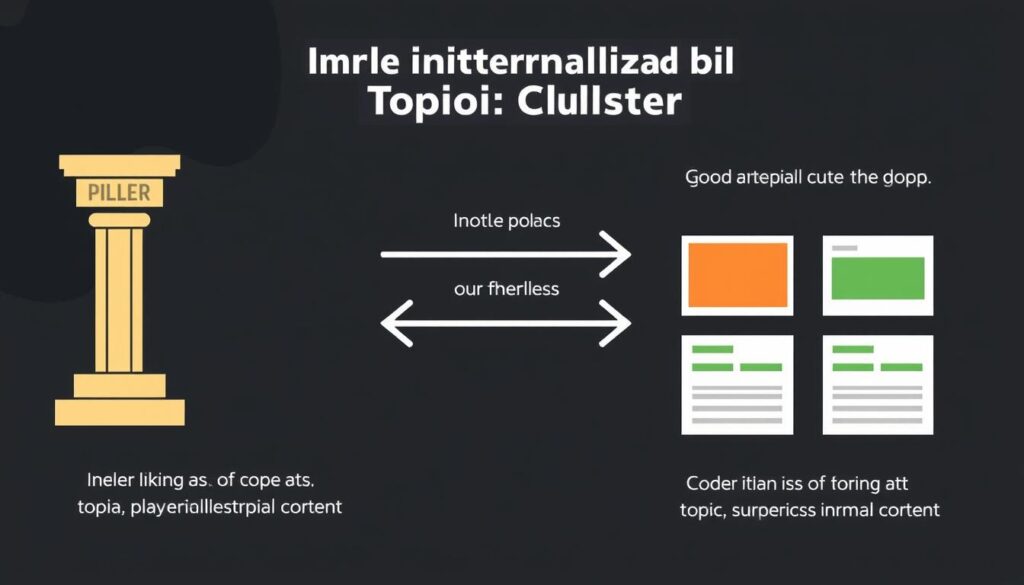
Internal linking implementation for topic clusters
Real-World Examples of Successful Topic Clusters
Let’s examine three successful implementations of topic clusters across different industries to inspire your own strategy.
Example 1: HubSpot’s Inbound Marketing Cluster
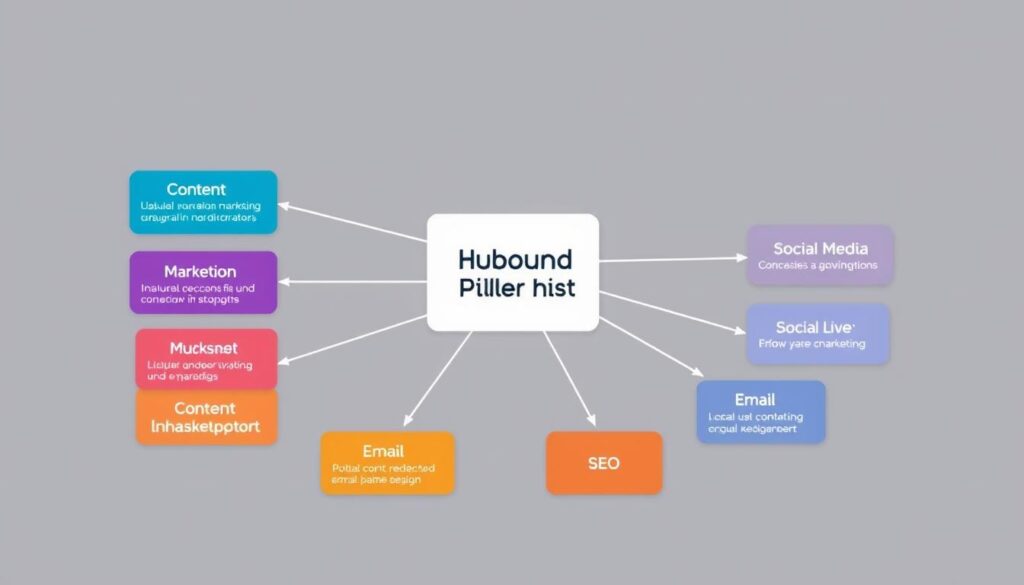
HubSpot’s inbound marketing topic cluster structure
| Component | Description | Results |
| Pillar Page | Comprehensive guide to inbound marketing | Ranks for 450+ keywords |
| Cluster Content | 25+ articles on specific inbound marketing tactics | Each ranks for 50-200 keywords |
| Traffic Impact | Before: 15,000 monthly organic visits | After: 45,000+ monthly organic visits |
Example 2: Ahrefs’ SEO Learning Hub
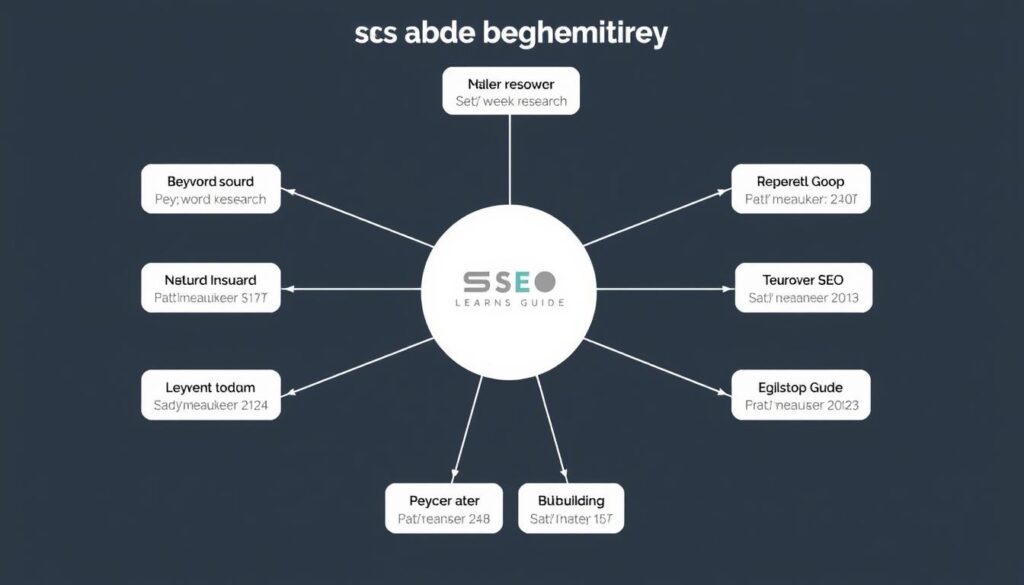
Ahrefs’ SEO learning hub topic cluster structure
| Component | Description | Results |
| Pillar Page | Beginner’s Guide to SEO | Ranks for 1,200+ keywords |
| Cluster Content | 40+ in-depth guides on SEO subtopics | Each ranks for 100-500 keywords |
| Traffic Impact | Before: 25,000 monthly organic visits | After: 85,000+ monthly organic visits |
Example 3: Wine Folly’s Wine Guide
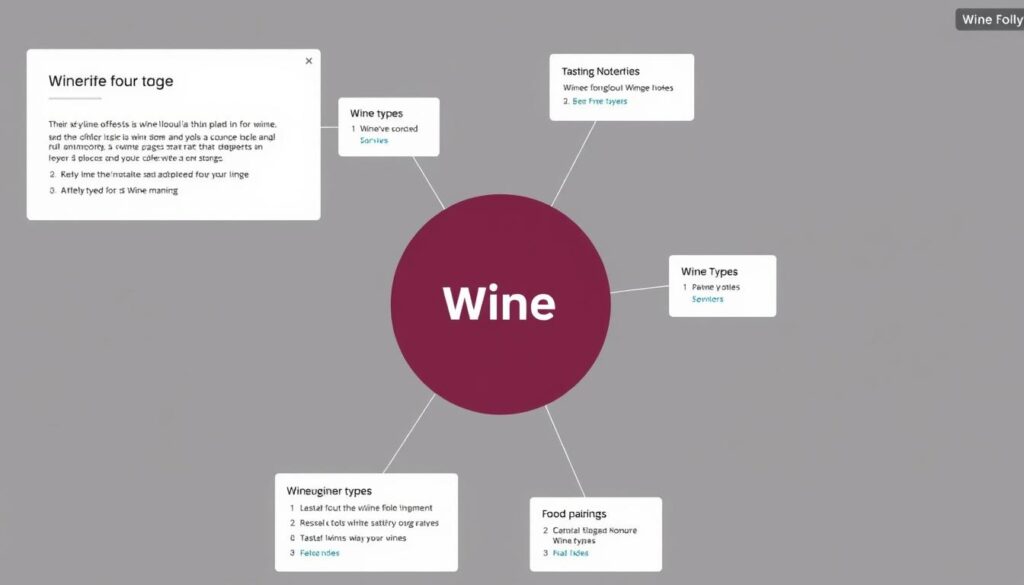
Wine Folly’s wine guide topic cluster structure
| Component | Description | Results |
| Pillar Page | Wine Basics – A Beginner’s Guide | Ranks for 800+ keywords |
| Cluster Content | 40+ articles on wine types, regions, etc. | Each ranks for 30-300 keywords |
| Traffic Impact | Before: 10,000 monthly organic visits | After: 35,000+ monthly organic visits |
Free Downloadable Templates
To help you implement topic clusters effectively, we’ve created a set of free templates that will save you hours of planning and implementation time.
Topic Cluster Mapping Spreadsheet
Plan your entire topic cluster strategy with this comprehensive spreadsheet template. Track pillar topics, cluster content, keywords, and internal linking opportunities all in one place.

Content Calendar Template
Organize and schedule your topic cluster content creation with this ready-to-use content calendar. Plan your pillar and cluster content publication schedule for maximum impact.

Internal Linking Checklist
Ensure your topic clusters are properly connected with this internal linking checklist. Track all necessary links between pillar and cluster content to maximize SEO benefits.
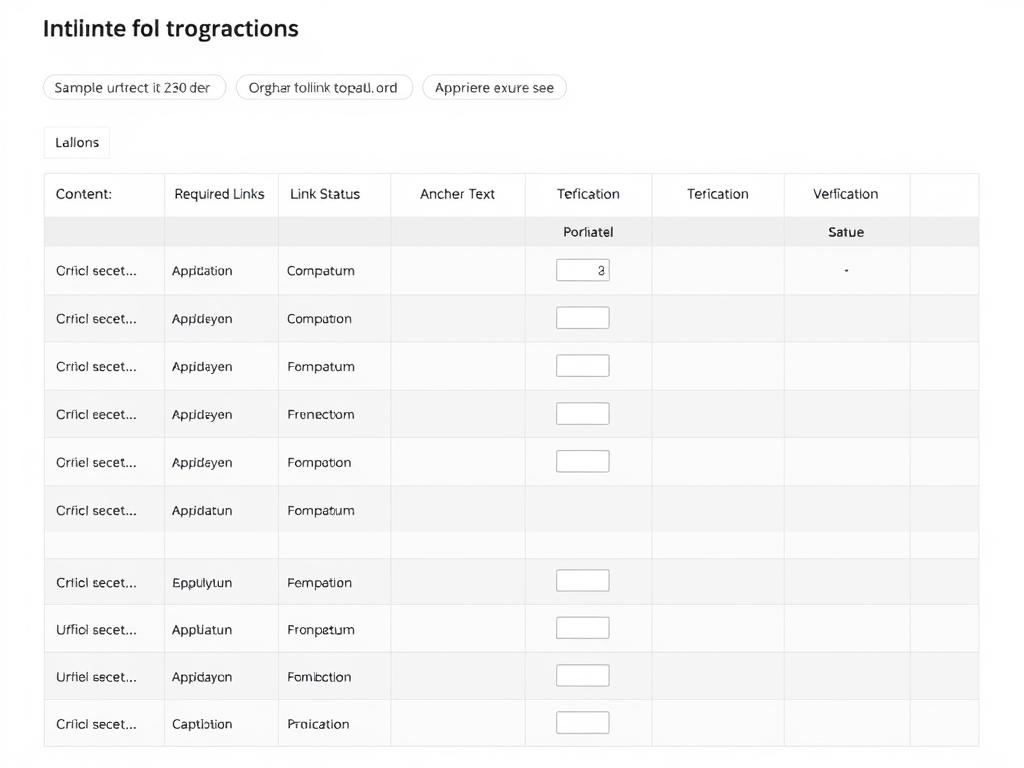
Best Practices and Common Mistakes to Avoid
Best Practices
- Focus on user intent when creating both pillar and cluster content
- Ensure pillar pages comprehensively cover the main topic
- Use consistent anchor text for internal links
- Regularly update and expand your topic clusters
- Monitor performance and refine your strategy based on data
- Create clear content hierarchies that users can easily navigate
- Align topic clusters with your business goals and expertise
Common Mistakes
- Creating overlapping content that cannibalizes rankings
- Focusing too much on keywords and not enough on topics
- Making pillar pages too narrow in scope
- Neglecting to update internal links as content grows
- Creating artificial clusters that don’t match user search behavior
- Overcomplicating your site structure
- Forgetting to measure and analyze performance
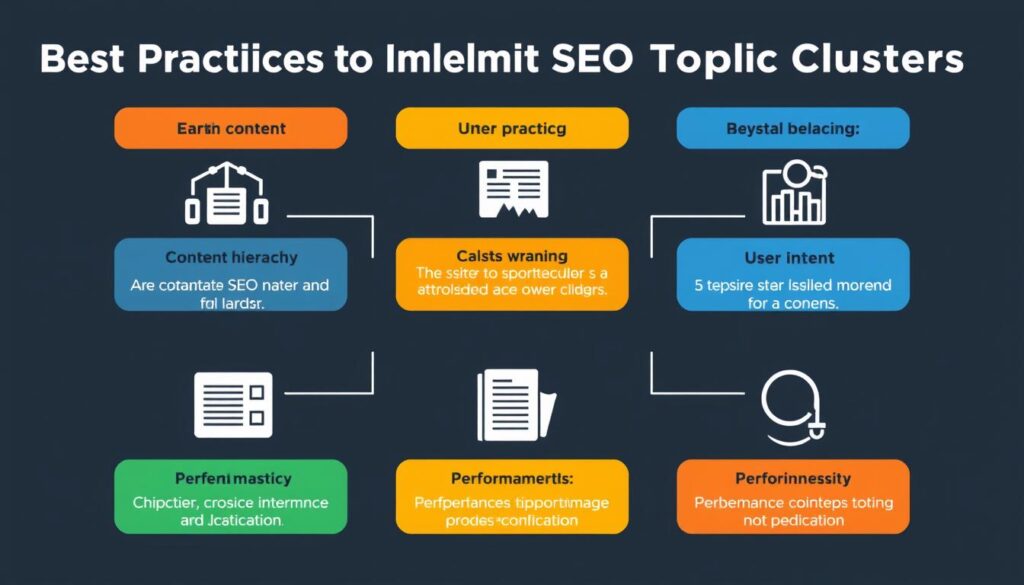
Best practices for implementing effective topic clusters
Common Pitfall: Many websites create topic clusters based solely on keyword volume without considering user intent or content overlap. Always check SERPs to understand what type of content Google considers relevant for your target keywords.
Tools for Building and Maintaining Topic Clusters
Several tools can help you research, build, and maintain effective topic clusters:

Essential tools for topic cluster creation and management
| Tool | Purpose | Key Features |
| Ahrefs | Keyword research and competitive analysis | Keyword Explorer, Content Gap, Site Explorer |
| SEMrush | Topic research and content planning | Topic Research, SEO Content Template, On-Page SEO Checker |
| MarketMuse | Content optimization and gap analysis | Content Inventory, Topic Modeling, Content Briefs |
| HubSpot Content Strategy Tool | Topic cluster planning and tracking | Visual Topic Mapping, Performance Tracking, Content Suggestions |
| Google Analytics & Search Console | Performance monitoring | Traffic Analysis, Keyword Tracking, User Behavior Insights |
Frequently Asked Questions
What’s the difference between topic clusters and content silos?
While both topic clusters and content silos organize content hierarchically, they differ in structure and purpose:
- Topic Clusters: Use a hub-and-spoke model with a central pillar page linking to related cluster content. The focus is on creating a network of interlinked content around a specific topic.
- Content Silos: Organize content in a strict hierarchical structure, often reflecting URL structure (e.g., domain.com/category/subcategory/page). Silos typically limit cross-linking between different topic areas to maintain clear category boundaries.
Topic clusters tend to be more flexible and better aligned with how modern search engines understand content relationships, while silos focus more on strict categorization.
How many cluster pages should I have per pillar?
There’s no fixed rule for how many cluster pages you should have per pillar, but most effective topic clusters typically include 8-30 cluster pages per pillar. The right number depends on:
- The breadth of your pillar topic
- Available subtopics with sufficient search volume
- Your content creation resources
- Your audience’s information needs
Focus on quality over quantity. It’s better to have fewer, high-quality cluster pages that thoroughly cover important subtopics than many thin pages with little value.
How long does it take to see results from topic clusters?
Results from implementing topic clusters typically begin to appear within 3-6 months, though this varies based on:
- Your website’s existing authority
- The competitiveness of your chosen topics
- The quality and comprehensiveness of your content
- How quickly you implement the complete cluster
Be patient and continue to refine your approach based on performance data. The full benefits of topic clusters often become more apparent over time as search engines better understand the relationships between your content.
Can I have multiple pillar pages targeting related topics?
Yes, you can and should have multiple pillar pages targeting different but related topics. For example, if you run a digital marketing agency, you might have separate pillar pages for “SEO,” “Content Marketing,” and “Social Media Marketing.”
The key is to ensure each pillar page focuses on a distinct topic with minimal overlap. When topics are closely related, you can create strategic links between different pillar pages to show search engines how these broader topics relate to each other.
Conclusion: Building Your SEO Topic Cluster Strategy
SEO topic clusters represent a strategic approach to content organization that aligns with how modern search engines understand and rank content. By creating comprehensive pillar pages supported by in-depth cluster content, you can establish topical authority, improve your site architecture, and provide a better user experience.
Remember that successful implementation requires careful planning, consistent execution, and ongoing refinement based on performance data. Use the templates and strategies outlined in this guide to build effective topic clusters that boost your organic visibility and establish your website as an authoritative resource in your industry.
Ready to Implement Topic Clusters?
Get started with our free templates and transform your content strategy today.
editor's pick
latest video
news via inbox
Nulla turp dis cursus. Integer liberos euismod pretium faucibua
you might also like
- Electric powertrains and autonomous driving are key trends.
- Sustainability is a major focus for future car designs.
- Innovative technology will enhance the driving experience.
- Several models are expected to be unveiled by major manufacturers.
- The industry is moving towards eco-friendly materials and production methods.
- Electrification of vehicles
- Autonomous driving technologies
- Advanced safety features
- High-definition mapping
- Dedicated short-range communication (DSRC) technology
- Advanced traffic management systems
- Less chance of accidents because of people’s mistakes
- Better communication with everything around them
- Quicker and more effective emergency responses
- Electric powertrains and autonomous driving are key trends.
- Sustainability is a major focus for future car designs.
- Innovative technology will enhance the driving experience.
- Several models are expected to be unveiled by major manufacturers.
- The industry is moving towards eco-friendly materials and production methods.
- Electrification of vehicles
- Autonomous driving technologies
- Advanced safety features
- High-definition mapping
- Dedicated short-range communication (DSRC) technology
- Advanced traffic management systems
- Less chance of accidents because of people’s mistakes
- Better communication with everything around them
- Quicker and more effective emergency responses
- Electric powertrains and autonomous driving are key trends.
- Sustainability is a major focus for future car designs.
- Innovative technology will enhance the driving experience.
- Several models are expected to be unveiled by major manufacturers.
- The industry is moving towards eco-friendly materials and production methods.
- Electrification of vehicles
- Autonomous driving technologies
- Advanced safety features
- High-definition mapping
- Dedicated short-range communication (DSRC) technology
- Advanced traffic management systems
- Less chance of accidents because of people’s mistakes
- Better communication with everything around them
- Quicker and more effective emergency responses
The car world is about to change a lot. Innovative automobiles are coming that will change how we drive. Looking ahead to 2025, many future cars are getting a lot of attention.
These new cars will bring new tech, designs, and ways to be green. They will set new standards for the car world.
The top cars of 2025 will have the latest electric powertrains and self-driving tech. They will also use eco-friendly materials. This marks a big step towards a greener future.
Key Takeaways
The Future of Automotive Innovation
Automotive innovation is on the rise for 2025, thanks to new tech and rules. The industry is moving towards being more green and high-tech. This is changing how cars are made and used.
How 2025 Will Reshape the Automotive Landscape
2025 will change the car world a lot. New cars and tech will make people want different things. This will change how we see and use cars.
Key trends shaping the industry include:
Key Driving Forces Behind Automotive Evolution
Many things are pushing the car world to change. Knowing these is key to understanding 2025’s impact.
Technological Advancements
New tech is leading the car world’s growth. Things like advanced battery technology and autonomous driving systems will change how we travel.
Regulatory Changes
Rules are also important for the car world. Governments are making laws to help electric cars and cut down on pollution.
| Driving Force | Impact on Industry | Expected Outcome |
|---|---|---|
| Technological Advancements | Increased adoption of electric and autonomous vehicles | Reduced carbon footprint |
| Regulatory Changes | Stricter emissions regulations | Increased production of eco-friendly vehicles |
Top Cars of 2025: Electric Revolution
2025 is a big year for electric cars. Many top models are leading the way. The shift to electric is driven by tech, the environment, and what people want.
Tesla Cybertruck 2.0 and Model 2
Tesla is leading the electric car charge with new models. The Tesla Cybertruck 2.0 will have better performance and range. The Tesla Model 2 will be more affordable, making electric cars for more people.
Rivian R2 and R3 Compact SUV
Rivian is making waves in electric SUVs with the R2 and R3. The Rivian R2 is a compact SUV with great range and performance. The Rivian R3 is smaller, perfect for city driving.
Lucid Air Gravity and Upcoming Models
Lucid Motors is adding the Lucid Air Gravity to its lineup. It’s an electric SUV that combines luxury and power. Lucid’s future models will push electric tech even further.
Ford’s Next-Generation Electric F-Series and Mustang
Ford is making its classic models electric. The next Electric F-Series and Mustang will mix tradition with modern tech. They promise great performance and green driving.
The electric car revolution is about more than new models. It’s also about the tech and features they bring. Here’s a look at some key features of the mentioned models:
| Model | Range (miles) | 0-60 mph (seconds) | Price (USD) |
|---|---|---|---|
| Tesla Cybertruck 2.0 | 500+ | 2.9 | 100,000 |
| Rivian R2 | 400+ | 3.0 | 60,000 |
| Lucid Air Gravity | 500+ | 2.5 | 120,000 |
| Ford Electric F-Series | 300+ | 4.0 | 70,000 |
Autonomous Driving Breakthroughs
As we approach 2025, autonomous driving is getting smarter and safer. It’s changing how we see transportation. These changes are big and will make driving better.
Level 4 Autonomy Becomes Mainstream
Level 4 autonomy means cars can drive on their own in many situations. This is a big step forward. It’s set to change the car industry a lot.
Infrastructure Requirements
To use Level 4 cars everywhere, we need better roads and systems. This includes dedicated lanes and communication systems. These will help cars talk to the world around them.
Some key things we need are:
Safety Implications
Level 4 cars could make roads much safer. They use advanced sensors and AI to avoid accidents better than people can.
The main safety benefits are:
Top Self-Driving Models to Watch
Many car makers are working on self-driving tech. Their cars will change how we drive.
General Motors Ultra Cruise Vehicles
General Motors is leading with Ultra Cruise. It lets cars drive without hands in many situations. We’ll see it in GM cars soon.
Waymo is teaming up with big car makers to make self-driving cars faster. These partnerships will bring Level 4 cars to more models.
Waymo’s work with car makers is a big step towards making self-driving cars real.
Luxury Redefined: Premium Models of 2025
The year 2025 is set to change the luxury car world with new tech and designs. Car makers are pushing limits to make top models that stand out.
Luxury cars are now more than just cars. They are turning into tech centers on wheels. With AI, green materials, and new designs, owning a luxury car is changing.
Mercedes-Benz Vision EQXX Production Model
The Mercedes-Benz Vision EQXX shows the brand’s focus on new tech and green cars. It has an electric engine and sleek design. Key features include a top-notch electric motor and a battery that saves energy.
BMW i8 Successor and i7 M70
BMW is introducing a new i8 that mixes speed with green tech. The i7 M70 will have exceptional driving and a fancy inside. These cars will boost BMW’s luxury status.
Audi Grand Sphere and Skysphere Concepts
Audi’s Grand Sphere and Skysphere show off new luxury with their looks and tech. The Grand Sphere is a peek at future luxury sedans. It has a spacious interior and cool tech inside.
Bentley’s First Full Electric and Rolls-Royce Spectre Evolution
Bentley is launching its first electric car, a big step for green luxury. Rolls-Royce is updating the Spectre with new tech and luxury touches. It will keep its top spot in car excellence.
These new luxury cars will set high standards for the future. They mix green tech, innovation, and luxury. The luxury car world is looking bright with new ideas leading the way.
Affordable Innovation: Budget-Friendly Future Cars
Looking ahead to 2025, the car world is changing. It’s not just about new tech, but also about making cars more affordable. Electric vehicles (EVs) are becoming more accessible thanks to better tech and a growing need for green transport.
Introducing budget-friendly models is key to making EVs more popular. Many car makers are planning to launch affordable electric cars.
Hyundai IONIQ7 and Affordable EV Lineup
Hyundai is set to change the game with its IONIQ7 model. It promises a great mix of range, features, and price. This makes it a great choice for those watching their budget. Hyundai’s plans to grow its EV lineup are good news for those seeking affordable options.
Kia EV5 and EV3 Compact Crossover
Kia is also making waves with its EV5 and EV3 models. These compact crossovers blend style, function, and affordability well. With their competitive prices and rich features, Kia’s EV5 and EV3 are set to win over many buyers.
Chevrolet Equinox EV Plus and Bolt EUV Successor
Chevrolet is also in the game with the Equinox EV Plus and the next Bolt EUV. These models promise a great mix of affordability, range, and features. The Equinox EV Plus is expected to be a strong contender in the compact SUV market, giving good value for money.
To better understand these models, here’s a summary table:
| Model | Expected Price | Range | Key Features |
|---|---|---|---|
| Hyundai IONIQ7 | $35,000 | 300 miles | Advanced safety features, spacious interior |
| Kia EV5 | $32,000 | 250 miles | Panoramic sunroof, premium audio system |
| Chevrolet Equinox EV Plus | $30,000 | 320 miles | Super Cruise technology, spacious cargo area |
The table shows the competitive prices and impressive features of these upcoming models. As the car world keeps evolving, it’s clear that affordability will play a big role in the adoption of electric vehicles.
Groundbreaking Automotive Technology for 2025
The car industry is on the verge of a big change. New technologies will change how we travel in 2025.
Next-Generation Battery Technology
Electric cars are becoming more popular. New battery tech is key. It will make cars go further, charge faster, and use less energy.
Solid-State Batteries
Solid-state batteries are a big deal. They charge faster and hold more energy than old batteries. Experts say they’ll be in most electric cars by the mid-2020s.
“Solid-state batteries represent a significant leap forward in battery technology, enabling longer ranges and reduced charging times,” said a leading automotive analyst.
Fast-Charging Capabilities
New cars can charge to 80% in under 15 minutes. This makes long trips in electric cars easier.
Advanced Materials and Manufacturing
New materials and ways to make cars are changing the game. Cars are now lighter and use less fuel. This helps the environment.
Revolutionary Infotainment and Connectivity
Car tech is getting better. Cars now connect with our phones and update themselves. This makes driving more fun and convenient.
Safety Innovations and Driver Assistance
Safety is a big focus. New cars will have better safety features. They’ll help avoid accidents and keep you safe on the road.
These new technologies will change driving for the better. Cars will be safer, more efficient, and more connected than ever.
Performance Vehicles: Speed Meets Sustainability
Performance and sustainability are now possible together, thanks to new car tech. The year 2025 is expected to be a big year for fast cars that are also good for the planet. Car makers are working hard to make cars that are both quick and kind to the environment.
Porsche Mission X Production Version
Porsche’s Mission X is going to change the electric supercar world. It will have advanced aerodynamics and state-of-the-art battery technology. This means it will be very fast and also good for the planet.
Ferrari’s First Full Electric Supercar
Ferrari is making its first full electric supercar. It will have cutting-edge electric propulsion and a design that keeps Ferrari’s style. But it will also be eco-friendly.
Lamborghini Lanzador and Hybrid Successors
Lamborghini’s Lanzador is a big step into the future of fast cars. It combines hybrid technology with amazing speed. The Lanzador and other hybrids from Lamborghini will set new standards for fast cars.
The mix of speed and green tech in these cars is a big change for the car world. As car makers keep innovating, the future of fast cars looks bright and green.
Environmental Impact and Sustainability Trends
As 2025 approaches, the car industry is working hard to cut down on environmental harm. This isn’t just a passing trend. It’s a big change that covers all parts of making and using cars.
Carbon-Neutral Manufacturing Processes
One key part of this effort is making car factories carbon-neutral. Companies are using more solar and wind power to lower their carbon output. For example, Tesla and Volkswagen are adding solar panels to their factories to cut down on fossil fuel use.
They’re also working to make production more efficient and waste-free. New tech like AI and IoT helps make this happen. It makes factories run better and hurts the environment less.
Sustainable Materials in Vehicle Production
Using sustainable materials is another big focus. Car makers are adding recycled and recyclable parts to their cars. BMW, for instance, is using recycled plastics and natural fibers in their cars. This cuts down on the need for new materials and lessens environmental harm.
There’s also a push for bio-based materials like bioplastics and natural composites. These are better for the planet than regular materials. They help cut down on carbon emissions and make cars easier to recycle when they’re done.
Lifecycle Assessment of 2025 Models
Doing lifecycle assessments (LCAs) is now common in the car world. LCAs look at a car’s environmental impact from start to finish. This includes making the car, using it, and what happens to it when it’s done.
By studying a car’s whole life, makers can find ways to make it better. They can choose better materials, design smarter, and make production greener. This way, they can make eco-friendly cars that are good for the planet and help us all live better.
Conclusion: The Road Ahead for Automotive Excellence
The automotive world is on the verge of a big change. This change comes from new tech, what people want, and the need to protect our planet. Looking ahead to 2025 and later, electric cars, self-driving cars, and luxury will shape the future.
New cars hitting the market will change everything. Brands like Tesla, Rivian, Lucid, and Ford are leading with electric vehicles. Self-driving cars will also make big strides, with Level 4 autonomy becoming more common.
But it’s not just about new tech. Making cars better for the planet is key too. Companies are working to make their factories green, use eco-friendly materials, and think about the whole life of their cars.
The future of cars is looking bright and full of possibilities. With a focus on new tech, being green, and making customers happy, the automotive world is set for great things.
FAQ
What are the top cars of 2025?
What advancements can we expect in automotive technology in 2025?
Are there any affordable electric vehicles coming out in 2025?
How will autonomous driving evolve in 2025?
What luxury car models can we expect in 2025?
What impact will 2025 cars have on the environment?
Will there be any performance vehicles that are also sustainable in 2025?
How will the automotive industry achieve sustainability in 2025?
The car world is about to change a lot. Innovative automobiles are coming that will change how we drive. Looking ahead to 2025, many future cars are getting a lot of attention.
These new cars will bring new tech, designs, and ways to be green. They will set new standards for the car world.
The top cars of 2025 will have the latest electric powertrains and self-driving tech. They will also use eco-friendly materials. This marks a big step towards a greener future.
Key Takeaways
The Future of Automotive Innovation
Automotive innovation is on the rise for 2025, thanks to new tech and rules. The industry is moving towards being more green and high-tech. This is changing how cars are made and used.
How 2025 Will Reshape the Automotive Landscape
2025 will change the car world a lot. New cars and tech will make people want different things. This will change how we see and use cars.
Key trends shaping the industry include:
Key Driving Forces Behind Automotive Evolution
Many things are pushing the car world to change. Knowing these is key to understanding 2025’s impact.
Technological Advancements
New tech is leading the car world’s growth. Things like advanced battery technology and autonomous driving systems will change how we travel.
Regulatory Changes
Rules are also important for the car world. Governments are making laws to help electric cars and cut down on pollution.
| Driving Force | Impact on Industry | Expected Outcome |
|---|---|---|
| Technological Advancements | Increased adoption of electric and autonomous vehicles | Reduced carbon footprint |
| Regulatory Changes | Stricter emissions regulations | Increased production of eco-friendly vehicles |
Top Cars of 2025: Electric Revolution
2025 is a big year for electric cars. Many top models are leading the way. The shift to electric is driven by tech, the environment, and what people want.
Tesla Cybertruck 2.0 and Model 2
Tesla is leading the electric car charge with new models. The Tesla Cybertruck 2.0 will have better performance and range. The Tesla Model 2 will be more affordable, making electric cars for more people.
Rivian R2 and R3 Compact SUV
Rivian is making waves in electric SUVs with the R2 and R3. The Rivian R2 is a compact SUV with great range and performance. The Rivian R3 is smaller, perfect for city driving.
Lucid Air Gravity and Upcoming Models
Lucid Motors is adding the Lucid Air Gravity to its lineup. It’s an electric SUV that combines luxury and power. Lucid’s future models will push electric tech even further.
Ford’s Next-Generation Electric F-Series and Mustang
Ford is making its classic models electric. The next Electric F-Series and Mustang will mix tradition with modern tech. They promise great performance and green driving.
The electric car revolution is about more than new models. It’s also about the tech and features they bring. Here’s a look at some key features of the mentioned models:
| Model | Range (miles) | 0-60 mph (seconds) | Price (USD) |
|---|---|---|---|
| Tesla Cybertruck 2.0 | 500+ | 2.9 | 100,000 |
| Rivian R2 | 400+ | 3.0 | 60,000 |
| Lucid Air Gravity | 500+ | 2.5 | 120,000 |
| Ford Electric F-Series | 300+ | 4.0 | 70,000 |
Autonomous Driving Breakthroughs
As we approach 2025, autonomous driving is getting smarter and safer. It’s changing how we see transportation. These changes are big and will make driving better.
Level 4 Autonomy Becomes Mainstream
Level 4 autonomy means cars can drive on their own in many situations. This is a big step forward. It’s set to change the car industry a lot.
Infrastructure Requirements
To use Level 4 cars everywhere, we need better roads and systems. This includes dedicated lanes and communication systems. These will help cars talk to the world around them.
Some key things we need are:
Safety Implications
Level 4 cars could make roads much safer. They use advanced sensors and AI to avoid accidents better than people can.
The main safety benefits are:
Top Self-Driving Models to Watch
Many car makers are working on self-driving tech. Their cars will change how we drive.
General Motors Ultra Cruise Vehicles
General Motors is leading with Ultra Cruise. It lets cars drive without hands in many situations. We’ll see it in GM cars soon.
Waymo is teaming up with big car makers to make self-driving cars faster. These partnerships will bring Level 4 cars to more models.
Waymo’s work with car makers is a big step towards making self-driving cars real.
Luxury Redefined: Premium Models of 2025
The year 2025 is set to change the luxury car world with new tech and designs. Car makers are pushing limits to make top models that stand out.
Luxury cars are now more than just cars. They are turning into tech centers on wheels. With AI, green materials, and new designs, owning a luxury car is changing.
Mercedes-Benz Vision EQXX Production Model
The Mercedes-Benz Vision EQXX shows the brand’s focus on new tech and green cars. It has an electric engine and sleek design. Key features include a top-notch electric motor and a battery that saves energy.
BMW i8 Successor and i7 M70
BMW is introducing a new i8 that mixes speed with green tech. The i7 M70 will have exceptional driving and a fancy inside. These cars will boost BMW’s luxury status.
Audi Grand Sphere and Skysphere Concepts
Audi’s Grand Sphere and Skysphere show off new luxury with their looks and tech. The Grand Sphere is a peek at future luxury sedans. It has a spacious interior and cool tech inside.
Bentley’s First Full Electric and Rolls-Royce Spectre Evolution
Bentley is launching its first electric car, a big step for green luxury. Rolls-Royce is updating the Spectre with new tech and luxury touches. It will keep its top spot in car excellence.
These new luxury cars will set high standards for the future. They mix green tech, innovation, and luxury. The luxury car world is looking bright with new ideas leading the way.
Affordable Innovation: Budget-Friendly Future Cars
Looking ahead to 2025, the car world is changing. It’s not just about new tech, but also about making cars more affordable. Electric vehicles (EVs) are becoming more accessible thanks to better tech and a growing need for green transport.
Introducing budget-friendly models is key to making EVs more popular. Many car makers are planning to launch affordable electric cars.
Hyundai IONIQ7 and Affordable EV Lineup
Hyundai is set to change the game with its IONIQ7 model. It promises a great mix of range, features, and price. This makes it a great choice for those watching their budget. Hyundai’s plans to grow its EV lineup are good news for those seeking affordable options.
Kia EV5 and EV3 Compact Crossover
Kia is also making waves with its EV5 and EV3 models. These compact crossovers blend style, function, and affordability well. With their competitive prices and rich features, Kia’s EV5 and EV3 are set to win over many buyers.
Chevrolet Equinox EV Plus and Bolt EUV Successor
Chevrolet is also in the game with the Equinox EV Plus and the next Bolt EUV. These models promise a great mix of affordability, range, and features. The Equinox EV Plus is expected to be a strong contender in the compact SUV market, giving good value for money.
To better understand these models, here’s a summary table:
| Model | Expected Price | Range | Key Features |
|---|---|---|---|
| Hyundai IONIQ7 | $35,000 | 300 miles | Advanced safety features, spacious interior |
| Kia EV5 | $32,000 | 250 miles | Panoramic sunroof, premium audio system |
| Chevrolet Equinox EV Plus | $30,000 | 320 miles | Super Cruise technology, spacious cargo area |
The table shows the competitive prices and impressive features of these upcoming models. As the car world keeps evolving, it’s clear that affordability will play a big role in the adoption of electric vehicles.
Groundbreaking Automotive Technology for 2025
The car industry is on the verge of a big change. New technologies will change how we travel in 2025.
Next-Generation Battery Technology
Electric cars are becoming more popular. New battery tech is key. It will make cars go further, charge faster, and use less energy.
Solid-State Batteries
Solid-state batteries are a big deal. They charge faster and hold more energy than old batteries. Experts say they’ll be in most electric cars by the mid-2020s.
“Solid-state batteries represent a significant leap forward in battery technology, enabling longer ranges and reduced charging times,” said a leading automotive analyst.
Fast-Charging Capabilities
New cars can charge to 80% in under 15 minutes. This makes long trips in electric cars easier.
Advanced Materials and Manufacturing
New materials and ways to make cars are changing the game. Cars are now lighter and use less fuel. This helps the environment.
Revolutionary Infotainment and Connectivity
Car tech is getting better. Cars now connect with our phones and update themselves. This makes driving more fun and convenient.
Safety Innovations and Driver Assistance
Safety is a big focus. New cars will have better safety features. They’ll help avoid accidents and keep you safe on the road.
These new technologies will change driving for the better. Cars will be safer, more efficient, and more connected than ever.
Performance Vehicles: Speed Meets Sustainability
Performance and sustainability are now possible together, thanks to new car tech. The year 2025 is expected to be a big year for fast cars that are also good for the planet. Car makers are working hard to make cars that are both quick and kind to the environment.
Porsche Mission X Production Version
Porsche’s Mission X is going to change the electric supercar world. It will have advanced aerodynamics and state-of-the-art battery technology. This means it will be very fast and also good for the planet.
Ferrari’s First Full Electric Supercar
Ferrari is making its first full electric supercar. It will have cutting-edge electric propulsion and a design that keeps Ferrari’s style. But it will also be eco-friendly.
Lamborghini Lanzador and Hybrid Successors
Lamborghini’s Lanzador is a big step into the future of fast cars. It combines hybrid technology with amazing speed. The Lanzador and other hybrids from Lamborghini will set new standards for fast cars.
The mix of speed and green tech in these cars is a big change for the car world. As car makers keep innovating, the future of fast cars looks bright and green.
Environmental Impact and Sustainability Trends
As 2025 approaches, the car industry is working hard to cut down on environmental harm. This isn’t just a passing trend. It’s a big change that covers all parts of making and using cars.
Carbon-Neutral Manufacturing Processes
One key part of this effort is making car factories carbon-neutral. Companies are using more solar and wind power to lower their carbon output. For example, Tesla and Volkswagen are adding solar panels to their factories to cut down on fossil fuel use.
They’re also working to make production more efficient and waste-free. New tech like AI and IoT helps make this happen. It makes factories run better and hurts the environment less.
Sustainable Materials in Vehicle Production
Using sustainable materials is another big focus. Car makers are adding recycled and recyclable parts to their cars. BMW, for instance, is using recycled plastics and natural fibers in their cars. This cuts down on the need for new materials and lessens environmental harm.
There’s also a push for bio-based materials like bioplastics and natural composites. These are better for the planet than regular materials. They help cut down on carbon emissions and make cars easier to recycle when they’re done.
Lifecycle Assessment of 2025 Models
Doing lifecycle assessments (LCAs) is now common in the car world. LCAs look at a car’s environmental impact from start to finish. This includes making the car, using it, and what happens to it when it’s done.
By studying a car’s whole life, makers can find ways to make it better. They can choose better materials, design smarter, and make production greener. This way, they can make eco-friendly cars that are good for the planet and help us all live better.
Conclusion: The Road Ahead for Automotive Excellence
The automotive world is on the verge of a big change. This change comes from new tech, what people want, and the need to protect our planet. Looking ahead to 2025 and later, electric cars, self-driving cars, and luxury will shape the future.
New cars hitting the market will change everything. Brands like Tesla, Rivian, Lucid, and Ford are leading with electric vehicles. Self-driving cars will also make big strides, with Level 4 autonomy becoming more common.
But it’s not just about new tech. Making cars better for the planet is key too. Companies are working to make their factories green, use eco-friendly materials, and think about the whole life of their cars.
The future of cars is looking bright and full of possibilities. With a focus on new tech, being green, and making customers happy, the automotive world is set for great things.
FAQ
What are the top cars of 2025?
What advancements can we expect in automotive technology in 2025?
Are there any affordable electric vehicles coming out in 2025?
How will autonomous driving evolve in 2025?
What luxury car models can we expect in 2025?
What impact will 2025 cars have on the environment?
Will there be any performance vehicles that are also sustainable in 2025?
How will the automotive industry achieve sustainability in 2025?
The car world is about to change a lot. Innovative automobiles are coming that will change how we drive. Looking ahead to 2025, many future cars are getting a lot of attention.
These new cars will bring new tech, designs, and ways to be green. They will set new standards for the car world.
The top cars of 2025 will have the latest electric powertrains and self-driving tech. They will also use eco-friendly materials. This marks a big step towards a greener future.
Key Takeaways
The Future of Automotive Innovation
Automotive innovation is on the rise for 2025, thanks to new tech and rules. The industry is moving towards being more green and high-tech. This is changing how cars are made and used.
How 2025 Will Reshape the Automotive Landscape
2025 will change the car world a lot. New cars and tech will make people want different things. This will change how we see and use cars.
Key trends shaping the industry include:
Key Driving Forces Behind Automotive Evolution
Many things are pushing the car world to change. Knowing these is key to understanding 2025’s impact.
Technological Advancements
New tech is leading the car world’s growth. Things like advanced battery technology and autonomous driving systems will change how we travel.
Regulatory Changes
Rules are also important for the car world. Governments are making laws to help electric cars and cut down on pollution.
| Driving Force | Impact on Industry | Expected Outcome |
|---|---|---|
| Technological Advancements | Increased adoption of electric and autonomous vehicles | Reduced carbon footprint |
| Regulatory Changes | Stricter emissions regulations | Increased production of eco-friendly vehicles |
Top Cars of 2025: Electric Revolution
2025 is a big year for electric cars. Many top models are leading the way. The shift to electric is driven by tech, the environment, and what people want.
Tesla Cybertruck 2.0 and Model 2
Tesla is leading the electric car charge with new models. The Tesla Cybertruck 2.0 will have better performance and range. The Tesla Model 2 will be more affordable, making electric cars for more people.
Rivian R2 and R3 Compact SUV
Rivian is making waves in electric SUVs with the R2 and R3. The Rivian R2 is a compact SUV with great range and performance. The Rivian R3 is smaller, perfect for city driving.
Lucid Air Gravity and Upcoming Models
Lucid Motors is adding the Lucid Air Gravity to its lineup. It’s an electric SUV that combines luxury and power. Lucid’s future models will push electric tech even further.
Ford’s Next-Generation Electric F-Series and Mustang
Ford is making its classic models electric. The next Electric F-Series and Mustang will mix tradition with modern tech. They promise great performance and green driving.
The electric car revolution is about more than new models. It’s also about the tech and features they bring. Here’s a look at some key features of the mentioned models:
| Model | Range (miles) | 0-60 mph (seconds) | Price (USD) |
|---|---|---|---|
| Tesla Cybertruck 2.0 | 500+ | 2.9 | 100,000 |
| Rivian R2 | 400+ | 3.0 | 60,000 |
| Lucid Air Gravity | 500+ | 2.5 | 120,000 |
| Ford Electric F-Series | 300+ | 4.0 | 70,000 |
Autonomous Driving Breakthroughs
As we approach 2025, autonomous driving is getting smarter and safer. It’s changing how we see transportation. These changes are big and will make driving better.
Level 4 Autonomy Becomes Mainstream
Level 4 autonomy means cars can drive on their own in many situations. This is a big step forward. It’s set to change the car industry a lot.
Infrastructure Requirements
To use Level 4 cars everywhere, we need better roads and systems. This includes dedicated lanes and communication systems. These will help cars talk to the world around them.
Some key things we need are:
Safety Implications
Level 4 cars could make roads much safer. They use advanced sensors and AI to avoid accidents better than people can.
The main safety benefits are:
Top Self-Driving Models to Watch
Many car makers are working on self-driving tech. Their cars will change how we drive.
General Motors Ultra Cruise Vehicles
General Motors is leading with Ultra Cruise. It lets cars drive without hands in many situations. We’ll see it in GM cars soon.
Waymo is teaming up with big car makers to make self-driving cars faster. These partnerships will bring Level 4 cars to more models.
Waymo’s work with car makers is a big step towards making self-driving cars real.
Luxury Redefined: Premium Models of 2025
The year 2025 is set to change the luxury car world with new tech and designs. Car makers are pushing limits to make top models that stand out.
Luxury cars are now more than just cars. They are turning into tech centers on wheels. With AI, green materials, and new designs, owning a luxury car is changing.
Mercedes-Benz Vision EQXX Production Model
The Mercedes-Benz Vision EQXX shows the brand’s focus on new tech and green cars. It has an electric engine and sleek design. Key features include a top-notch electric motor and a battery that saves energy.
BMW i8 Successor and i7 M70
BMW is introducing a new i8 that mixes speed with green tech. The i7 M70 will have exceptional driving and a fancy inside. These cars will boost BMW’s luxury status.
Audi Grand Sphere and Skysphere Concepts
Audi’s Grand Sphere and Skysphere show off new luxury with their looks and tech. The Grand Sphere is a peek at future luxury sedans. It has a spacious interior and cool tech inside.
Bentley’s First Full Electric and Rolls-Royce Spectre Evolution
Bentley is launching its first electric car, a big step for green luxury. Rolls-Royce is updating the Spectre with new tech and luxury touches. It will keep its top spot in car excellence.
These new luxury cars will set high standards for the future. They mix green tech, innovation, and luxury. The luxury car world is looking bright with new ideas leading the way.
Affordable Innovation: Budget-Friendly Future Cars
Looking ahead to 2025, the car world is changing. It’s not just about new tech, but also about making cars more affordable. Electric vehicles (EVs) are becoming more accessible thanks to better tech and a growing need for green transport.
Introducing budget-friendly models is key to making EVs more popular. Many car makers are planning to launch affordable electric cars.
Hyundai IONIQ7 and Affordable EV Lineup
Hyundai is set to change the game with its IONIQ7 model. It promises a great mix of range, features, and price. This makes it a great choice for those watching their budget. Hyundai’s plans to grow its EV lineup are good news for those seeking affordable options.
Kia EV5 and EV3 Compact Crossover
Kia is also making waves with its EV5 and EV3 models. These compact crossovers blend style, function, and affordability well. With their competitive prices and rich features, Kia’s EV5 and EV3 are set to win over many buyers.
Chevrolet Equinox EV Plus and Bolt EUV Successor
Chevrolet is also in the game with the Equinox EV Plus and the next Bolt EUV. These models promise a great mix of affordability, range, and features. The Equinox EV Plus is expected to be a strong contender in the compact SUV market, giving good value for money.
To better understand these models, here’s a summary table:
| Model | Expected Price | Range | Key Features |
|---|---|---|---|
| Hyundai IONIQ7 | $35,000 | 300 miles | Advanced safety features, spacious interior |
| Kia EV5 | $32,000 | 250 miles | Panoramic sunroof, premium audio system |
| Chevrolet Equinox EV Plus | $30,000 | 320 miles | Super Cruise technology, spacious cargo area |
The table shows the competitive prices and impressive features of these upcoming models. As the car world keeps evolving, it’s clear that affordability will play a big role in the adoption of electric vehicles.
Groundbreaking Automotive Technology for 2025
The car industry is on the verge of a big change. New technologies will change how we travel in 2025.
Next-Generation Battery Technology
Electric cars are becoming more popular. New battery tech is key. It will make cars go further, charge faster, and use less energy.
Solid-State Batteries
Solid-state batteries are a big deal. They charge faster and hold more energy than old batteries. Experts say they’ll be in most electric cars by the mid-2020s.
“Solid-state batteries represent a significant leap forward in battery technology, enabling longer ranges and reduced charging times,” said a leading automotive analyst.
Fast-Charging Capabilities
New cars can charge to 80% in under 15 minutes. This makes long trips in electric cars easier.
Advanced Materials and Manufacturing
New materials and ways to make cars are changing the game. Cars are now lighter and use less fuel. This helps the environment.
Revolutionary Infotainment and Connectivity
Car tech is getting better. Cars now connect with our phones and update themselves. This makes driving more fun and convenient.
Safety Innovations and Driver Assistance
Safety is a big focus. New cars will have better safety features. They’ll help avoid accidents and keep you safe on the road.
These new technologies will change driving for the better. Cars will be safer, more efficient, and more connected than ever.
Performance Vehicles: Speed Meets Sustainability
Performance and sustainability are now possible together, thanks to new car tech. The year 2025 is expected to be a big year for fast cars that are also good for the planet. Car makers are working hard to make cars that are both quick and kind to the environment.
Porsche Mission X Production Version
Porsche’s Mission X is going to change the electric supercar world. It will have advanced aerodynamics and state-of-the-art battery technology. This means it will be very fast and also good for the planet.
Ferrari’s First Full Electric Supercar
Ferrari is making its first full electric supercar. It will have cutting-edge electric propulsion and a design that keeps Ferrari’s style. But it will also be eco-friendly.
Lamborghini Lanzador and Hybrid Successors
Lamborghini’s Lanzador is a big step into the future of fast cars. It combines hybrid technology with amazing speed. The Lanzador and other hybrids from Lamborghini will set new standards for fast cars.
The mix of speed and green tech in these cars is a big change for the car world. As car makers keep innovating, the future of fast cars looks bright and green.
Environmental Impact and Sustainability Trends
As 2025 approaches, the car industry is working hard to cut down on environmental harm. This isn’t just a passing trend. It’s a big change that covers all parts of making and using cars.
Carbon-Neutral Manufacturing Processes
One key part of this effort is making car factories carbon-neutral. Companies are using more solar and wind power to lower their carbon output. For example, Tesla and Volkswagen are adding solar panels to their factories to cut down on fossil fuel use.
They’re also working to make production more efficient and waste-free. New tech like AI and IoT helps make this happen. It makes factories run better and hurts the environment less.
Sustainable Materials in Vehicle Production
Using sustainable materials is another big focus. Car makers are adding recycled and recyclable parts to their cars. BMW, for instance, is using recycled plastics and natural fibers in their cars. This cuts down on the need for new materials and lessens environmental harm.
There’s also a push for bio-based materials like bioplastics and natural composites. These are better for the planet than regular materials. They help cut down on carbon emissions and make cars easier to recycle when they’re done.
Lifecycle Assessment of 2025 Models
Doing lifecycle assessments (LCAs) is now common in the car world. LCAs look at a car’s environmental impact from start to finish. This includes making the car, using it, and what happens to it when it’s done.
By studying a car’s whole life, makers can find ways to make it better. They can choose better materials, design smarter, and make production greener. This way, they can make eco-friendly cars that are good for the planet and help us all live better.
Conclusion: The Road Ahead for Automotive Excellence
The automotive world is on the verge of a big change. This change comes from new tech, what people want, and the need to protect our planet. Looking ahead to 2025 and later, electric cars, self-driving cars, and luxury will shape the future.
New cars hitting the market will change everything. Brands like Tesla, Rivian, Lucid, and Ford are leading with electric vehicles. Self-driving cars will also make big strides, with Level 4 autonomy becoming more common.
But it’s not just about new tech. Making cars better for the planet is key too. Companies are working to make their factories green, use eco-friendly materials, and think about the whole life of their cars.
The future of cars is looking bright and full of possibilities. With a focus on new tech, being green, and making customers happy, the automotive world is set for great things.

